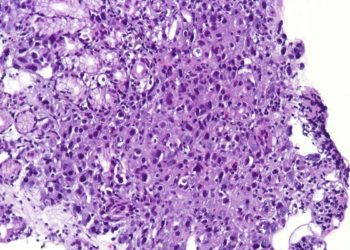2 Minute Medicine Rewind February 8, 2021
Total knee replacement after high tibial osteotomy: time-to-event analysis and predictors
1. 5 and 10 years after undergoing a high tibial osteotomy procedure, 95% and 79% of knee osteoarthritis patients respectively did not require a total knee replacement.
2. Preoperative factors associated with an increased rate of conversion to total knee replacement included greater radiographic severity, female sex, greater knee pain, higher BMI, and older age.
Evidence Rating Level: 2 (Good)
Knee osteoarthritis (OA) has a peak prevalence at age 50 worldwide, which dramatically impacts middle-aged individuals in terms of quality of life and ability to work. Currently, the use of total knee replacement (TKR) is on the rise for middle-aged patients, although TKR done too early has been linked to lower patient satisfaction and greater risk of prosthesis infection. In fact, 25% of TKR procedures are classified as “likely inappropriate”, underlying the need for alternative knee OA treatments. A procedure known as high tibial osteotomy (HTO) has been used to postpone the need for a TKR, although it is not commonly performed in Canada. In this single-center prospective cohort studies, researchers aimed to quantify the conversion time from HTO to TKR and examining pre-HTO characteristics associated with the conversion time. From 2002 to 2014, 643 knees in 556 patients had a medial opening wedge HTO procedure done, and by the end of the study in 2019, 103 TKRs (16.0%) were done. At 5 years, the cumulative incidence of conversion to TKR was 5%, and at 10 years, the incidence was 21%. Furthermore, for female patients the incidence was 7% and 32%, and for early-stage disease patients it was 2% and 13%, at 5 and 10 years respectively. In terms of pre-HTO characteristics, greater radiographic disease severity was the largest predictor of TKR conversion (adjusted hazards ratio 1.96, 95% CI 1.12-3.45). Other predictors of increased conversion rate include female sex, greater knee pain, higher BMI, and older age. Overall, the study showed that HTO is a procedure that can delay the need for a TKR in knee osteoarthritis patients, with 79% of patients not requiring a TKR 10 years after an HTO.
Use of high dose cyproterone acetate and risk of intracranial meningioma in women: cohort study
1. Long-term usage of cyproterone acetate (CPA) at high doses was associated with greater risk of meningioma development in females.
2. Discontinuation of CPA after one year decreased the relative risk associated with treatment.
Evidence Rating Level: 2 (Good)
Cyproterone acetate (CPA) is a hormone therapy treatment classified as as synthetic progestogen with antiandrogen effects. It is indicated for men with inoperable prostate cancer, and for women with hyperandrogenism and related conditions, such as hirsutism. Previously, studies have found a link between meningioma development and use of CPA at high doses (25-100 mg) in the long term (5-30 years). Historically, studies have reported this association in men but not women. The current observational cohort study investigated the association between meningioma and high dose, prolonged use of CPA in girls and women, including the risk after discontinuation of CPA, and the risk of meningioma for transgender female patients. The study based in France compared the incidence of meningioma between an exposed cohort of female patients who received long-term, high dose CPA, and a control cohort consisting of patients who were only slight exposed to CPA and/or discontinued CPA prematurely (less than 3 grams). There were 253,777 patients in the main study (54.9% in the exposed cohort). The incidence was 23.8 per 100,000 person years in the exposed cohort and 4.5 per 100,000 person years in the control: The relative risk was 5.2 (95% CI 3.2-8.6) and the adjusted hazard ratio was 6.6 (95% CI 4.0-11.1). Higher doses were associated with greater risk (HR 11.3, 95% CI 5.8-22.2 for a dose of 36-60 g; HR 21.7, 95% CI 10.8-43.5 for a dose of 60+ g). After stopping CPA treatment for 1 year, the relative risk dropped to 1.8 (95% CI 1.0-3.2). In the analysis of 10,876 transgender patients, three patients in the exposed group developed a meningioma, leading to an incidence of 20.7 per 100,000 person years, whereas zero participants in the control group developed meningioma. Those three patients took high doses of 100-150 mg daily in the short-term, 3-4.5 years. Overall, this study found an increased risk of developing meningiomas in female patients using cyproterone acetate, although the risk is lowered after discontinuing treatment.
Pregnancy outcomes in women with moderate-to-severe psoriasis
1. Pregnant women using biologic treatments for psoriasis, both before and during pregnancy, were found to have similar pregnancy outcomes as the general American population.
Evidence Rating Level: 2 (Good)
Psoriasis is a chronic inflammatory skin disease affecting 7 million adults in the United States. It has been hypothesized that the chronic inflammatory state and association with psoriasis-related comorbid conditions such as diabetes and cardiovascular predispose pregnant women to complications. However, there is limited data due to exclusion of pregnant patients from clinical trials, and because psoriasis patients often stop treatment during pregnancy. The current prospective cohort study analyzed the fertility rate and pregnancy outcomes from patients in a longitudinal registry who were eligible for systemic and biologic therapies for their psoriasis. Out of 2,224 women of childbearing age (18-45 years) in the registry, there were 298 pregnancies from 220 patients between 2007 and 2019 (12,929 patient years). The fertility rate was 18.9 per 1000 women, which was lower than the general US population (59.1 per 1000 women). Out of the 298 pregnancies, there were 244 births including 1 stillborn (81.9%), 41 spontaneous abortions (13.8%), and 13 terminations (4.4%). 90.9% of live-births were full-term and 9.1% were premature. 94.7% of newborns were considered healthy, 10 infants (4.1%) had a neonatal issue, and 2 (0.8%) had congenital anomalies. As well, 252 of these pregnancies were in women exposed to biologic therapy both before or during pregnancy. The remaining 46 pregnant women may have received a non-biologic therapy, such as phototherapy, before or during pregnancy. The infants with congenital anomalies were from women who received the biologic ustekinumab, 1 outside of the prenatal period and 1 during. Overall, the pregnancy outcomes in terms of live-born infants, spontaneous abortions, terminations, and congenital abnormalities, are not significantly different from between the general US population and women using biologic treatments for psoriasis, although further studies using pregnancy-specific registries may be needed to increase the sample size.
Mental health, overdose, and violence outcomes and the COVID-19 pandemic
1. From March to October 2020, emergency departments in the United States have experienced a higher rate of visits from mental health related concerns, overdoses, and domestic abuse/violence, compared to the same months in 2019.
2. In the same period, emergency departments have experienced a higher absolute number of visits from mental health concerns and overdoses, but a lower absolute number from domestic abuse/violence.
Evidence Rating Level: 2 (Good)
The COVID-19 pandemic has led to the necessitation of stay-at-home orders and other physical distancing measures. This has been shown to lead to worsening mental health, with 1 in 7 American adults reporting psychological distress in April 2020, compared to 1 in 25 in April 2018. Furthermore, hotlines for domestic violence and child abuse spiked at the pandemic’s onset, which may have been a result of greater time spent with perpetrators of abuse. This cross-sectional study compared the number of mental health, substance use, and domestic violence related emergency department (ED) visits, before and during COVID-19 in the United States. The following factors from ED visits were analyzed: Mental health conditions (MHC), suicide attempts (SA), drug overdose (OD), intimate partner violence (IPV), and suspected child abuse neglect (SCAN). ED visits from December 2018 to October 2020 were analyzed, which amounted to 187,508,065 ED visits from 3500 facilities across the country. The results showed that ED visits across these outcomes decreased from March 8 compared to March 28, 2020 (March 16 was when COVID-19 measures were implemented). However, when comparing the median ED visits from March to October 2020, to the same period in 2019, significant differences were found. The 2020 visit counts were higher for SAs (4940 vs 4656, p = 0.02), all ODs (15,605 vs 13,371, p < 0.001), and opioid ODs specifically (5502 vs 4168, p < 0.001). Contrastingly, ED visit counts were lower for IPV (442 vs 484, p < 0.001) and SCAN (884 vs 1038, p < 0.001). However, although median counts were lower for some outcomes, median rates of ED visits for all of the outcomes were higher in the 2020 period than in the 2019 period: MHCs (2539.9 vs 2150.5, p < .001), SAs (310.8 vs 248.0, p < .001), all drug ODs (940.2 vs 711.1, p < .001), opioid ODs specifically (330.2 vs 222.3, p < .001), and SCAN (439.3 vs 286.3, p < .001). Overall, this study demonstrating that emergency departments during the COVID-19 pandemic have experienced a shift towards mental health, substance use, and domestic violence related visits, further highlighting the importance of robust screening and prevention strategies for these outcomes.
1. Higher consumption of refined grains, with the exception of white rice, was associated with a greater risk of total mortality, and mortality from cardiovascular disease related events.
2. Consumption of whole grains was not associated with greater or decreased risk of total mortality and cardiovascular disease mortality.
Evidence Rating Level: 2 (Good)
Previous research has established that greater consumption of refined carbohydrates is associated with numerous risk factors for cardiovascular disease (CVD). However, with much of this research occurring in North American and Europe, other areas of the world that consume different forms of carbohydrates primarily may impact these findings on CVD risk. For instance, cereal grains comprise 50% of caloric intake globally, but comprise 70% of intake in low and middle income countries, such as those in Africa and South Asia. There are currently mixed results on the association between refined grain consumption and mortality or CVD risk, whereas whole grains appear to be associated with lower mortality and CVD risk. In this prospective cohort study, researchers analyzed the association of refined grains, whole grains, and white rice, with outcomes such as mortality from CVD events, total mortality, and non-CVD mortality. White rice was analyzed separate from refined grains due to it being a main staple food in Asia. The study population consisted of 137,130 participants after excluding those with baseline CVD. This population was taken from the Prospective Urban and Rural Epidemiology (PURE) study, a prospective cohort study consisting of adults aged 35-70 years from 21 countries in 5 continents. There were 5 low income, 5 lower middle income, 7 upper middle income, and 4 high income countries in the PURE study. Participants received follow-up every three years, and those recruited between 2003 and 2019 were included in the study. Overall, the study found that participants consuming >350 g/day of refined grains had a significantly higher risk of mortality from CVD events, than those consuming <50 g/day (hazard ratio 1.28, 95% CI 1.15-1.42, p for trend < 0.001). For a 50 g increase in refined grain intake, the HR was 1.02 (95% CI 1.01-1.03). There were also significant differences for total mortality and non-CVD mortality. Furthermore, no associations were found between the clinical outcomes and consumption of whole grains or white rice. In conclusion, this study confirmed an association between mortality from CVD events or non-CVD causes, and higher consumption of refined grains, with the exception of white rice.
Image: PD
©2021 2 Minute Medicine, Inc. All rights reserved. No works may be reproduced without expressed written consent from 2 Minute Medicine, Inc. Inquire about licensing here. No article should be construed as medical advice and is not intended as such by the authors or by 2 Minute Medicine, Inc.






![Type I diabetes not associated with early menopause [OVADIA study]](https://www.2minutemedicine.com/wp-content/uploads/2014/12/diabetes1_edited-75x75.jpg)
